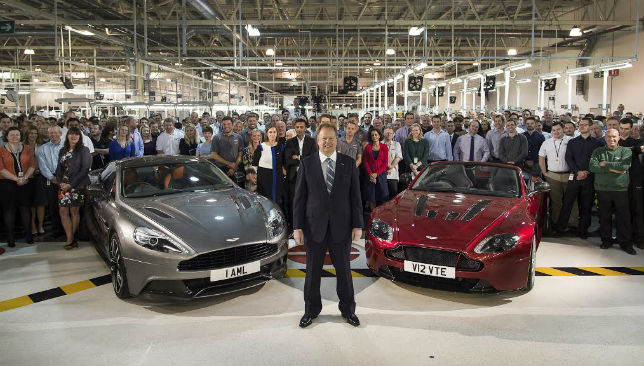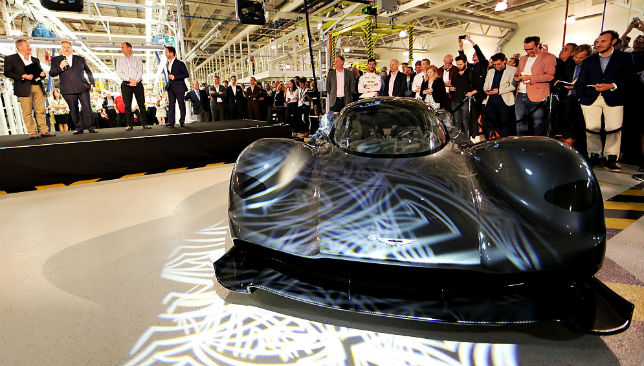
For the moment, James Bond may be more synonymous with Aston Martin than Andy Palmer but if things go to plan that may well change in the not too distant future.
Palmer has a mission to put Aston back into profit, to lead the 103-year-old company into what he calls ‘The Second Century’.
He has already refinanced the company which has had several owners over the years, transformed the management structure, launched the stunning new DB11, and formed a fascinating alliance with Red Bull Formula One team to produce a hypercar, the sensational looking AM-RB 001 (below).
He took some time away from his hectic schedule to talk to Sport360° editor Steve McKenlay about the future.
How long have you been with Aston Martin now?
For just over two years. Prior to that I was chief planning officer for Nissan based in Japan. I was 23 years with Nissan, 10 years in the UK and the rest of the time overseas and I am a mechanical engineer by training.
Aston came in for me. I had a little bit of insight into Aston beforehand because at Nissan we looked at whether they would fit into our portfolio or not so I had a reasonable understanding of the challenges but the turning point for me was the five per cent shareholding with Daimler which gave Aston access to the technology it clearly needed plus assurances from the two other shareholders, Investment Dar in Kuwait and Investindustrial in Italy, that they would back my plan.
What did you see before you came into Aston Martin that persuaded you to join them and what were the main challenges you expected to face?
What I saw was a great brand which I thought I could take somewhere special. There was an emotional side of that of course in that I reached 50 years old at Nissan where I had a great job and could have continued doing that.
However, I always wanted to be the CEO of a car company and I always thought it was a huge shame that the UK has barely any of its own car industry left.
Aston is it basically, so it was a bit of bringing the head and the heart together with a sincere belief that given the right team, the right challenge and the right motivation I could at least turn Aston into the British Ferrari. I don’t mean copy Ferrari but as a stand alone manufacturer and maybe more.
Ferrari already sets the bar high. It just recently had a successful IPO (Initial Public Share Offer) and set a very high target but we can go further because we aren’t limited to only making sports cars. We can do SUVs and Lagondas.
What was your opinion of Aston Martin cars when you joined the company?
The cars are great. We can talk about the old VH (vertical/horizontal platform) architecture but it was really ahead of its time but the models are ageing and in particular the electrical architecture was starting to show its age.
So, coming in I knew I wanted to do something about the navigation system in the cars which was one of its major weaknesses and I wanted to do something about the gearbox by giving an alternative to the single-clutch gearbox and update the interior. So, on a product basis it was a case of go ahead to do it.
I did all that and that is before the new product comes. There was a whole bunch of other things I needed to do within the first two years which was a stabilisation period. I put together a corporate plan which was approved at board level, got it funded and started to put the management structure in place.
I have taken out two levels of management trying to create a large flat structure, started a cost reduction programme and regrettably had to make some redundancies – about 400 – and started a whole new quality process. That comes from my Japanese training because they are obssessive about quality.
So that sort of marked the end of the beginning and we are just starting phase two which is core rebuilding which is the new sports cars, starting with the DB11.
I came to the launch of the new DB11 in Italy and one of the things that struck me was the enthusiasm of the team you now have. Was that enthusiasm already there ready to be tapped or have you introduced it?
There is definitely a real buzz around the place now and it wasn’t there when I came. I think that fundamentally we didn’t change too many people. There was a passion for the brand.
People work at Aston because they love cars but the company was spinning its wheels. There wasn’t really any approval of products there was nobody taking brave decisions so there wasn’t a lot of celebration of how good things could be because there wasn’t any money.
They went back to a kind of feudal system with the heads of all the functions basically protecting their patch and no real teamwork so the hardest thing to start with was the cultural change, engendering a team spirit with a clear, deployable plan and a leadership that works harder than anyone else.
So I think there was a lot of frustration amongst the workforce with nothing to channel the passion into.

New models are in the pipeline for Aston Martin.
The DB11, the first Aston produced under the partnership with Daimler, has been well received so what is next?
You and I are privileged to have driven the car but we need to tell everyone the story about what we have done which is why I will personally be inspecting the first 1000 cars that leave the factory. No car goes out of the factory without my assurance that it is a good car.
What does your inspection involve?
Twenty to thirty minutes depending on whether I decide to give it a test drive or not but it is principally around gaps and flushes, making sure everything works and that there is no damage to any materials interior and exterior.
There is an obssession with getting things right. I wouldn’t put my name on it if it wasn’t right and every car goes with my email address so if there is something wrong then I will hear about it and I answer all my emails.
Have you always been that hands on?
Yes, I left school at 16 and worked on a factory floor and I prefer it like that. I have other weaknesses but I like being on the shop floor.
Tell me more about the future of Aston as you see it.
The turnaround plan it is to make the most beautiful automotive art in the world from a great British car company. There are six pillars of the turnaround plan starting with the luxury products and not just cars – boats for example.
The second is making sure we have got a sales network which is capable of growing to, in the first instance, 7000 cars a year, and then double that; the third is about unrivalled quality; fourth is about great processes; fifth is about passionate, professional people the most important asset in the company and the sixth is having the finance and the discipline there which means we never have to go back to the begging bowl.
How difficult was it to fund your plan?
There were plenty of cynics for sure but the plan is extremely cohesive and my management team has credibility within the investment community and for the last seven quarters in a row I have bettered the budget we had set and that gives confidence to the financial community.
What new cars are next?
In terms of products the next is the new Vantage and then the Vanquish and that covers the next phase of the plan.
Are you going to replace all your models including the Rapide?
The Rapide will become electric. It fulfills two needs. I have obviously run electric car programmes before and I know how hard it is and I know that you need to concentrate on just the things that you are changing ie so it allows us to address that issue of understanding the technology.
It also allows us to meet emission regulations around the world and I think there is room for a luxury brand above Tesla so eventually the Rapide will become our vanguard of the electric car. Then we have the SUV code-named DBX and the Lagonda.
Motorsport has always been important to Aston. Have you considered entering Formula E which is now attracting all the major manufacturers?
Yes, and we will continue to consider it but we won’t be entering until the technology allows a race to be done on one battery.
If you want to be the first electric luxury car company it is a way of showcasing that so it is definitely on the agenda but I think having to change the battery by changing cars half way through the race is just reinforcing people’s perception that electric cars have a range issue.
That will change and I believe that 25 per cent of new car sales will be electric by 2025.
Aston does a lot of limited special edition cars and has just announced a hypercar in a partnership with Red Bull. How important is this business to Aston Martin?
In 103 years Aston has made just 80,000 cars and within a couple of years we are going to be making 7000 cars a year and then 10,000 plus so it’s suddenly a different sort of exclusivity. So in order to preserve the sort of exclusivity to get with a DB5 I want to make every year, two sets of low volume specials.
It also transforms the way people view our product line because we are selling out with significant over subscriptions on every one of these special series that we are doing.
So you are creating a head of steam with people who want to get close to the company and so they also get close to the core range and we now have more than 4000 orders for the DB11.
So, is the association with James Bond still part of your turnaround plan?
We are not Ferrari looking for that fraction of a second more speed, we are not Rolls-Royce and we are not the average of the two.
We position ourselves around the love of beauty and beautiful cars and we have to put it into the minds of the customers that the reason the fictional James Bond will drive that car is because of its beauty, its athleticism; because it suits what he is. He is one of the tools, like racing, that we use to market our brand. So yes, he is still important.